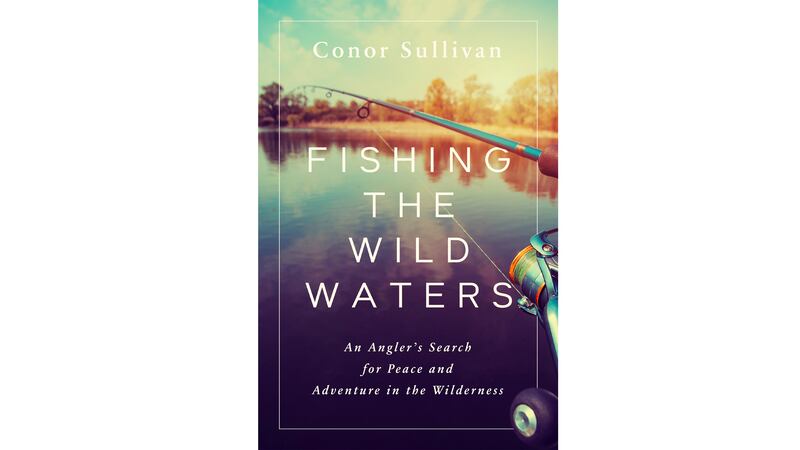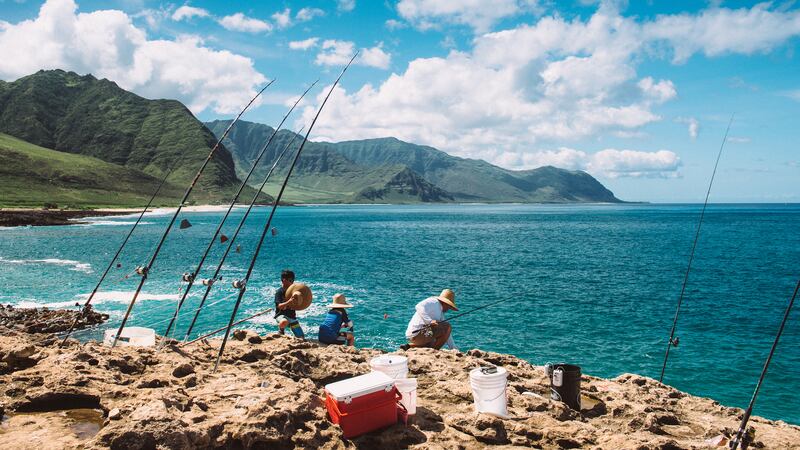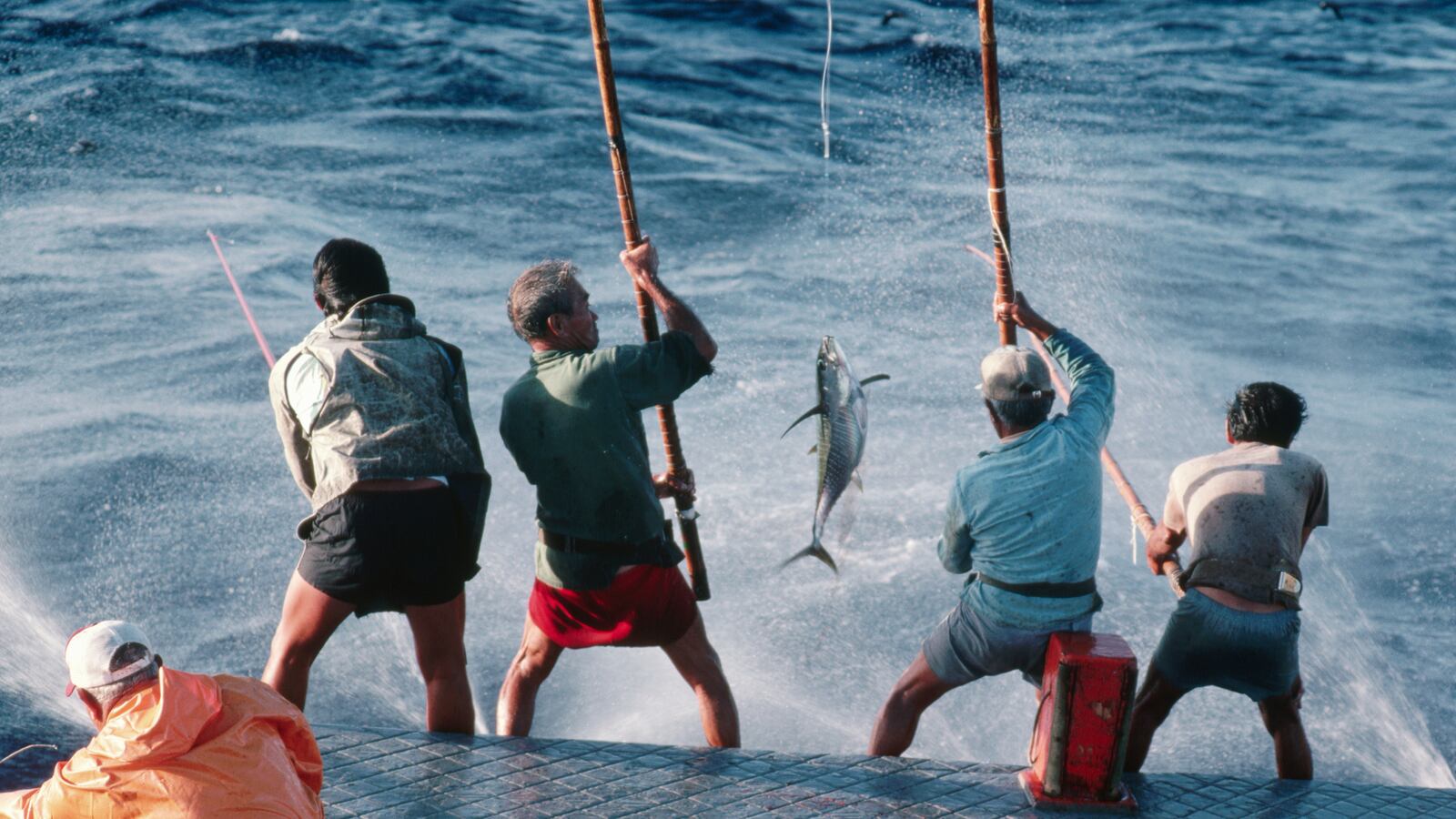In my eyes, Hawaiians are the best fishermen in the world. The ingenuity, pride, and cultural connection to the land and sea have always set the standard for me on a balanced life, well-lived. Hawaii is not an easy place to fish. Each island is surrounded by a ring of coral, which correspondingly has breaking surf, making open water access limited to certain channels. The warm, salty water eats any and all metal. The sea conditions can be demoralizing; don’t believe the brochures, the weather here is often a beast. I am comfortable making the statement that I have seen more consistently better sea states in summertime Alaska than in summertime Hawaii. Due to a nearly stationary high-pressure system to the northeast of the Hawaiian island chain, strong easterly “trade” winds are the norm. So, unless you live on the leeward side of the islands, be prepared to fish in some snotty seas.
The pristine, clear waters, although intoxicating to swim in, tell a story of the lack of plankton in the water. The lack of this basic building block in the food chain means that the total biomass just isn’t as prolific as it is elsewhere. The rivers don’t swell with salmon, or any fish for that matter, in Hawaii, as the fish stocks generally are just not as big. Each island is a desert oasis and every pelagic fish is a nomad.
To be consistently successful here sets an angler apart. The upshot is that the access to the big game species is mindblowing. Upon clearing the harbor breakwaters, you can deploy your trolling spread for big pelagics. Although the fiftieth state in the US, there are many unique cultural practices that are codified into fishing that are unique to the islands. Like Alaska, Hawaii is isolated. Geographically speaking, it is the most isolated islands on Earth. This makes the fuel more expensive, the requirement for self-reliance higher, and the adventure of it all just a little sweeter.
There are some amazing fisheries throughout the islands. Hawaiians created a method of fishing called slide-bait fishing to pursue ulua (giant trevally). Ulua routinely top one hundred pounds and are the premier fish for shore fishermen. To overcome the challenges of the lava coastline, which is prone to snags, slide bait fishermen purposely snag the bottom by casting out a sinker with wire arms like a grappling hook. With this main line secured, large baits like whole octopus, moray eels, or live reef fish are slid down the line.
To overcome the power of the mighty ulua, Hawaiian anglers have perfected the art of casting large conventional reels like Penn Senators, a feat that the rest of the country’s anglers did not think was possible—to provide the line capacity and drag rating to keep up with these fish. Upon taking a strike from an ulua, the sinker breaks free and the angler battles the fish, often at night, from the rocks. Slide-bait fishing is usually an overnight event, including a camp setup with multiple anglers casting out as many as a dozen separate rods.
Assortments of vividly colored fish live along the reef, each one prettier than the next, and are pursued by both anglers and spear fishermen. On the sandy flats, schools of o’io (bonefish) search for their next meal. They are a popular food fish in Hawaii, often made into fish cakes by the local fishermen. At night, I enjoyed walking the reefs and shallow waters, armed with a three-pronged spear and flashlight, searching for octopus, known locally as “tako.” But as fun as these activities can be, what the state is really known for is big game fishing.

Fishing the Wild Waters: An Angler's Search for Peace and Adventure in the Wilderness
Pegasus BooksJust beyond the reef line, monsters lurk. While most parts of the world require an extended boat ride to reach offshore grounds, in Hawaii they are literally just off the shore. Each island is the top of a large volcano, and it doesn’t take long to reach the offshore abyss. While in New England, it would take me well over one hundred miles to reach the 500-fathom line (one fathom equals six feet), in Hawaii, I could do it inside of eight miles from any port I launched from. Once offshore, there were no safe havens. If your boat broke down, there was nothing but open water for thousands of miles. To run a boat over the horizon in Hawaii was not for the faint of heart. You had to know your bearings, know your boat, and find a way to get home.
The major species a fisherman trolls for in Hawaiian waters are: ahi (yellowfin and bigeye tuna over one hundred pounds), mahi-mahi (dolphinfish), ono (wahoo) and all Pacific species of billfish (blue, black, striped, spearfish, and sailfish). About the only species you won’t find here are white marlin, as they are confined to the Atlantic Ocean. Like Alaska, fish here come with more than one name. There is the “mainland” name, the Hawaiian name, maybe a Japanese name, and sometimes a name based on the size of the fish. An example would be a skipjack tuna. Obviously, its common name is the skipjack tuna, its Hawaiian name is aku, but a big one over twenty pounds is called an “otado” or “otaru,” which is actually a city in Japan. Likewise, an ahi would be a yellowfin tuna over one hundred pounds, while one under that size would be a shibi.
Hawaii is not just a state, it’s an island nation. Local and native Hawaiians are proud of their heritage and seek to protect and perpetuate their culture against the never-ending barrage of commercialization of the islands. Apparently, everyone wants a piece of paradise. Being an outsider, a haole, it wasn’t always easy to break in. But it takes a fisherman to recognize a fisherman, and I would also say Hawaiians are some of the most welcoming and generous people I have met. Aloha, the island greeting, is not just a salutation. It translates more closely to the “breath of life.” Like gravity, it is easier to see the effects than the force. You give aloha and you get aloha. I have forged some of my deepest relationships on these islands, making close friends through the bond of being a waterman and fisherman.
At first glance you may not think there are seasons in Hawaii but after spending a year there, it becomes clear that there are. It takes more motivation to get into the water in winter than it does in summer. The seasons are felt both in terms of weather and fish. The ahi, ono, and big marlin arrive in the spring and stick around through the dry season (summer) to spawn. The mahi-mahi seem to surge in the fall and again in the spring. The rainy and cooler wintertime is slower, but striped marlin and spearfish appear in greater numbers. The seasonality is really only noticeable if you live here, but it provides a rhythm to follow.
With the exception of inshore reef fish and deepwater bottom fish, there are few licenses, size limits, or any real sense of regulations when it comes to offshore fishing in Hawaii. One’s initial reaction is that regulations are needed to protect the species and to level the playing field. What I learned plying the waters here is that the playing field is level. On the world’s most isolated rock, nomadic fish wander the currents of the Pacific. Fishermen depart from historic ports to troll the often-rough waters, using the same trolling techniques that have been employed for a century. Some of them, like deep dropping for tuna, in which anglers wrap their baited hook around a smooth rock, date back thousands of years.
Hawaii, as I see it, does not need many regulations because the ocean itself does a pretty good job of regulating the fishermen. I spent thousands of dollars on boats and sophisticated electronics only to find better success in following birds and looking for trash in the water when trying to locate where baitfish might be hiding. The inefficiency of trolling in mile-deep water, covering a seemingly barren sea, or straining your eyes for a bird pile regulates fishermen without much government intervention. That inefficiency, in my eyes, factors into the equation for fair chase.

"Ka'ena Point State Park, Oahu, USA - July 23, 2015: Hawaiian Family Fishing from the cliffs at Ka'ena Point State Park in Oahu. Hawaii"
ferrantraiteAncient Hawaiians had their own set of fishing restrictions, called kapus, which prohibited the taking of fish at certain times of the year, generally to protect spawning aggregations of inshore fish that were so crucial to their protein security. Being the most isolated islands on Earth with limited terrestrial animals to meet their protein needs, it was imperative to prevent overfishing of stocks and take only what was needed to subsist. Although they never crossed paths, early Hawaiians and native Alaskans have a lot in common. Skilled mariners, they both set out in small crafts onto big waters to intercept the seasonal migrations of fish that would come through their home waters with no guarantee of returning safely or finding the fish. A tradition from years past, Hawaiian boats still place the long leaves from the Ti plant in their rod holders as they set out to sea each morning to bring good luck and safe returns. I also appreciate the traditions of both locales of showing respect for the fish by using as much of it as possible; belly meat, eggs, cheeks, and even the collars (the thin horseshoe-shaped section of meat between the gills and pectoral fins) are all retained and little goes to waste as they share freely amongst their family and friends because the family, the ohana, the du yinaanàx, was and is still central to everything. I live my life by the same philosophy and these connections continue to draw me to both of these places.
Without intending to, Hawaiians have become the freethinkers of fish retention. The result or maybe perk of being left alone in the Pacific for centuries with your main protein source having fins has caused Hawaiians to consider all fish as being created equal. Few fish are elevated to the status of being too holy to be eaten. Billfish, bonefish, and everything in between are fair game for food. This leveling of prestige is unique to Hawaii, and fish are judged by their table fare rather than gamefish status. Alaska’s categories of fishing—commercial, subsistence, and recreational—are strictly separate; Hawaii rolls these three up into one. On most days, I would bet that a typical boat intends to touch on all three of those categories. With a simple state permit, anglers can sell pelagic (open water) fish for profit, even just a few to cover expenses, and bring home the rest to subsist off. It is a righteous concept, and I like it.
In an era of sustainability, eating local, knowing where your food comes from, and capturing fish on rod and reel are concepts that resonate. Fresh fish, caught by local, day-boat fishermen, is the antithesis to the industrialized fisheries found elsewhere. Much of the fish here is consumed raw, and having fresh fish is key to keeping it a positive experience for one’s digestive tract. Pre-contact with Western cultures, Hawaiians’ main source of protein was from the sea. Even today, the average American eats sixteen pounds of seafood a year. According to the University of Hawaii, residents of Hawaii consume twenty-eight and a half pounds a year.
Living in Hawaii opened my eyes to how good most pelagic fish tastes raw. One of the favorite local dishes is the poke bowl, which originated from fishermen in bygone days cutting the scraps of their catch for a quick snack and blossomed into a worldwide trend. Cubes of raw tuna, mixed with Hawaiian sea salt, green onions, soy sauce, sesame oil, and a host of other options are layered upon a bowl of rice. Today it is heavily influenced by many other Asian cuisines, but it remains one of the best meals I can imagine. It is so good that when I first experienced the taste, it was another strong motivator for me to become a commercial rod and reel fisherman.
Hawaiian fishermen are in a league of their own and continue to set the standard by which the rest of the trolling world compares themselves. Local lure makers, spanning back several generations, dedicate their life’s work to the pursuit of perfection in these lures. It is rare to see lures used in Hawaii that are not created in Hawaii. Walk into any tackle shop on the islands, and you will be amazed by the art forms that they call trolling lures, each head handmade by a local craftsman and equally appealing to both fishermen and fish. Local craftsmen like Ken Ching of KC lures, Eric Koyanagi of Koya lures, and hundreds of others create functional art from resin and sandpaper. Hawaiian anglers invented the highspeed lure trolling and resin lure making that is now practiced worldwide. The art of lure crafting for offshore fishing runs deep in tradition in Hawaii and it is replete with heroes like Joe Yee, George Parker, and Henry Chee that border on legends.
By the time I moved to Hawaii I had become a competent lure maker, but wood is a forgiving medium, and carving a lure from wood is more about taking away then adding. Pouring resin is different. It’s a medium I had never worked in. As a young kid, I actually broke a resin head lure apart just to see what was inside. To create a shape from a liquid, you must first create a mold, and then shape it with wet sandpaper. Resin, being clear, requires dyes and pigments to be added as well. In the center of any resin head lure is an insert, which serves as both the ballast and the primary visual attractant.
The creative combination of all these steps seemed an unsolvable riddle to me, and kept me as an outsider when it came to fashioning Hawaiian-style resin heads. Nevertheless, as I traveled the country, I always remained a Hawaiian-style fisherman. When I fished offshore around the mainland, I made it a point to troll Hawaiian-made resin heads. Unlike mass-produced plastic heads that most fishermen ran, the hand-turned Hawaiian heads stood out. They were shaped by a fellow fisherman, by hand, and they ran better. The mahi-mahi and tuna in New England never saw baits like this.
With my boat and my lures, I began in earnest to fish as hard as I could offshore Hawaii. But fishing the islands is not like anywhere else—it’s harder, it’s frustrating, and the end-of the-day “mercy bites” are rare. I have never been humbled quite like I have been in Hawaii. I had to work hard to find the fish, especially with a smaller boat, and routine small-craft advisory on rough weather days. Each trip was a lesson in being able to read the Pacific and determine, in its vast emptiness, where fish would congregate. It was a skill that had to be earned. There are no shortcuts or apps, just miles under the keel.

